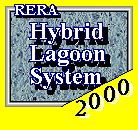
COPYRIGHTS
1999-2009 RERA
All right reserved.
Any Unauthorized
Copying
or Using Prohibited.
Preface
Table
of Contents
Foundation
Hybrid
Lagoon System
Case
Study
Applications
Proposals
Hybrid Lagoon System Technical note (1)

The
Booking 1986
The Internet version 2000
Hiroshi Kishi
Rural
Environment Research Association
Preface
The securement of a source of clean water is a necessary condition for the maintenance of human life, and history demonstrates it to be of fundamental importance for the formation of urban communities and the development of culture. However, only in recent years has it become apparent that, once used by man, unclean water may give rise to epidemics or wreak havoc on the environment, which we need to survive? It is also only recently that we have learned that microorganisms have, over a period of three billion years, been responsible for formation of the atmosphere, generation of the organic material in the soil, and production of clean water, all from the inorganic matter of the primitive earth. Hence microorganisms have played a major role in the emergence of today's world, temperate and teeming with life.
Having learned through experience that microorganisms in water and clinging to dirt and rocks act to cleanse water soiled by other living organisms, human beings at last had the idea of scientifically applying this action of microbes, and after much trial and error built up the present science of sanitation and constructed systems for treatment of waste water. Still, a number of problems remain, and society has imposed new demands, relating to advanced energy-efficient processing (denitrification, dephosphorization) and automatic control of current wastewater processing systems.
In light of this, it is my sincere hope that this manual on LLSB activated sludge treatment, which offers exceptional features and performance even while requiring only simple facilities, will promote a deeper understanding by the reader of today's technology for waste- water treatment, and enable a clear grasp both of current problems and of future solutions.
1.
Origins of the Activated Sludge Treatment
Method.
2. Basic Construction of
Facilities and Principle of Operation of the Activated Sludge
Treatment Method (1): Method of Continuous Operation.
3.
Basic Construction of Facilities and
Principle of Operation of the Activated Sludge Treatment Method
(2): Method of non-continuous Operation.[SBR]
4.
Characteristics and Functions of
Microorganisms.(1) General Characteristics;
5.
Characteristics and Functions of
Microorganisms (2) Denitrification Functions.
6. Survey
of LLSB Activated Sludge Treatment Functions, 1974-1976.
7.
Principle
8. How
to Operation
9. Basin Construction
cross-section, Lateral Section).
10. Water
Interception and Excavation without Timbering.
11. Water
Flow Model and Stirring Characteristics.
12. The
Hybrid Aerators System.
13. Automatic
Control System(1) Hard wear.
14. Automatic
Control System (2) Waves analysis and allosteric effect.
15.
Distributed Processing and Centralized
Control Systems.
16. Development of
Hybrid Lagoon Technology and Comparison of systems..
17.
Hybrid Lagoon Evaluation (1):
Denitrification Tests 1983.
18. Hybrid
Lagoon Evaluation (2): Sewage Treatment Facilities,
BCJ-57-551.1983.
19. Hybrid Lagoon
Performance (1): Meat processing wastewater plant, from 1981.
20.
Hybrid Lagoon Performance (2): Household
wastewater plant, from 1981.
21. Hybrid
Lagoon Performance (3): Cattle breeding wastewater
Denitrification Treatment plant from 1985.
22. Hybrid
Lagoon Performance (4): 10kliters Human Waste, from l985.
23.
Hybrid Lagoon Performance (5): 50kliters
Human Waste, from l982.
24. Hybrid
Lagoon Performance (6): Waste from Agricultural Community, from
1986.
25. Hybrid Lagoon Performance
(7): Starch Waste Water, from 1986.
26. Hybrid
Lagoon Performance (8): Noodle Processing wastewater from 1985.
27.
Future Plans. for Environmental Protection.
(1):Plans for Multifunctional Public Sewage Systems.
28.
Future Plans for Environmental Protection.
(2):From Facilities for Human Waste Processing to Sewage
Treatment Facilities.(600 kliters/day, 40,500 m3/day)